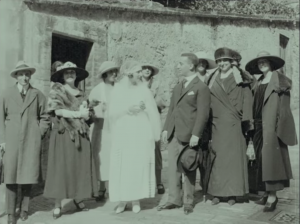NEWS ‘I Remember,’ films of Jewish life
These nine minutes tell the story of the cheerful daily life of those same people that years later would be upset by racial laws and the Shoah. These black and white images go by, showing Silvio Della Seta and Iole Campagnano’s wedding, a trip to the Anzio beach and another one to the mountains of Valtellina. It is a precious testimony of Jewish life, captured in 1923 by Salvatore Di Segni in eleven 35mm film reels, which unravel personal lives and the history of Italy at the time. The films were shot by Di Segni, found by journalist Claudio Della Seta and then restored; they are now stored at the Jewish Contemporary Documentation Centre (CDEC) in Milan.
“How many films like these still belong to families and are waiting for restoration?” wondered CDEC, that launched a national campaign to collect, digitalize and catalogue films saved by Jewish families in Italy. They have widened their range, both in space and time: “It is very hard to find films that are as precious as Di Segni’s or the Ovazza family’s (shot between 1930 and 1936) – CDEC director Gadi Luzzatto Voghera explained – That’s why our appeal also addresses post-war films, that are often underestimated by those who own them but, in our society of images, may become an important document to tell the story of Italian Judaism”.
The project, Luzzatto Voghera explained, was encouraged by the National Corporate Film Archive in Ivrea, that had previously promoted a similar initiative on families working for the Olivetti company. It was quite an exceptional research work, since Adriano Olivetti gave each one of his workers a camera. “This says a lot about how forward-looking personalities like Olivetti are – CDEC director underlined – The material filmed by workers has been important to tell the history of the local area. A similar research was conducted on the Waldensians as well. When we were offered this chance, we immediately took it. We will be supported by the Ministry of Cultural Heritage and Activities (MiBAC) and by important Jewish institutions.” The commitment will be shared by the National Museum of Italian Judaism and the Shoah (MEIS) in Ferrara, the Holocaust Museum in Milan, the Museum of the Shoah in Rome, the Jewish community of Turin and the National Museum of Cinema in Turin.
“Old family videos and home movies. This heritage is usually hidden in boxes and closets and it is impossible to see it because meanwhile the old family projectors have been lost. They are visual documents depicting family scenes, holidays, as well as views, city images or public events – CDEC explained launching the initiative – It is an important source, whose consultation can help scholars of contemporary history reconstruct frameworks and put a face and give voice to Jewish families and communities of the 20th century.”
The appeal addresses all Jewish families and people related to Judaism to make the films they own available to anyone. “It is not uncommon to think that these materials are not of public interest at all. Our researchers will have the opportunity to evaluate them to understand whether the films may contain elements of interest deserving to be valued instead” CDEC underlined.
The films will be collected at CDEC and the Holocaust Museum in Milan, at the Museum of the Shoah in Rome, at the Jewish community in Turin and at MEIS in Ferrara. They will then be digitalized at the National Corporate Film Archive in Ivrea and finally catalogued. “This phase, the cataloguing, is fundamental to create a systematic collection that researchers and scholars can use for their works. It is about offering cultural and scientific opportunities. And this would not be possible without the support of MiBAC and the Jewish institutions.”
The ultimate goal is to build an online archive, so that everybody can consult a visual recollection of the 20th century in Italy.
*Translated by Claudia Azzalini and revised by Mattia Stefani, both students at the Advanced School for Interpreters and Translators of Trieste University and interns at the newspaper office of the Union of the Italian Jewish Communities.

